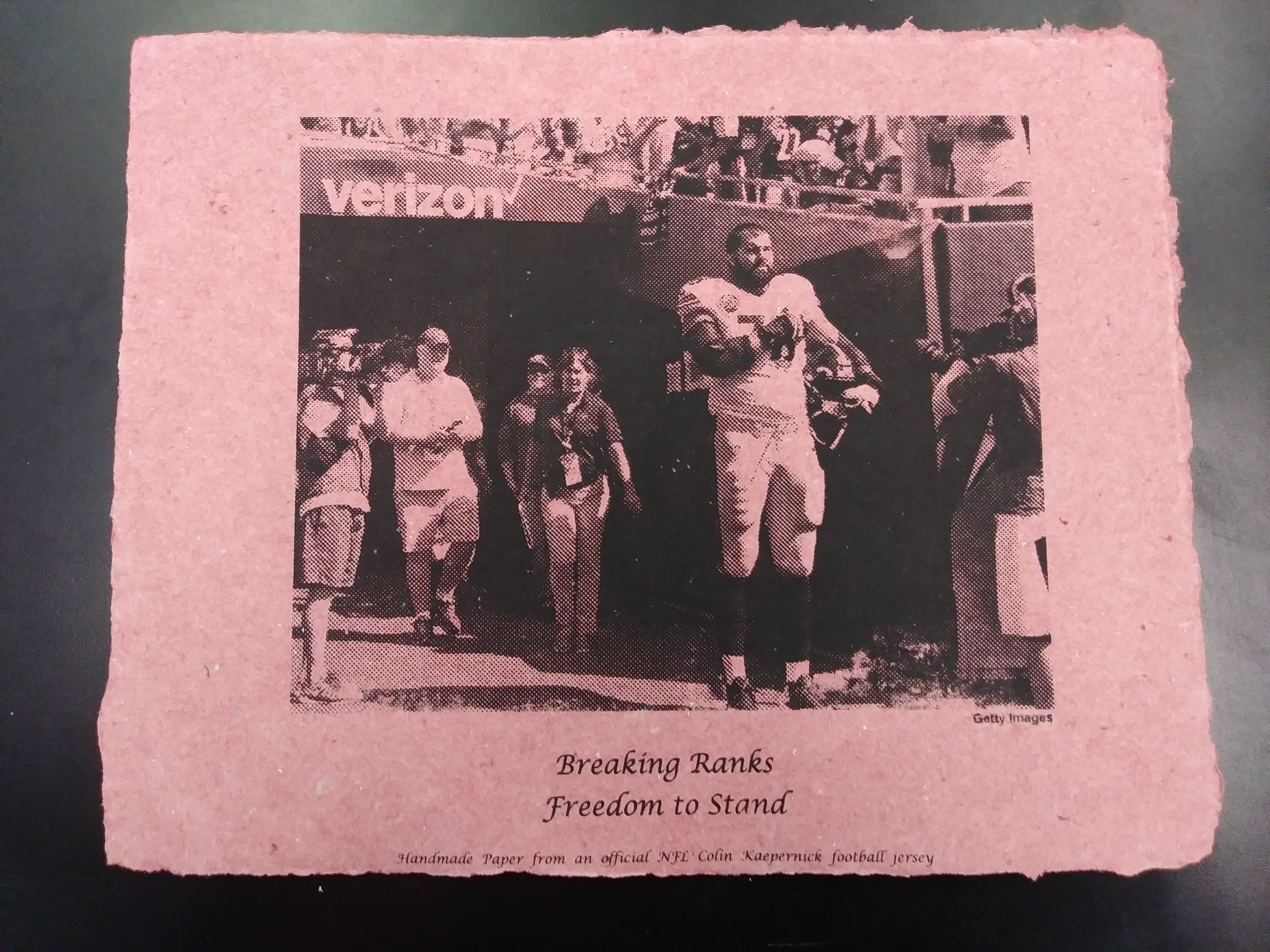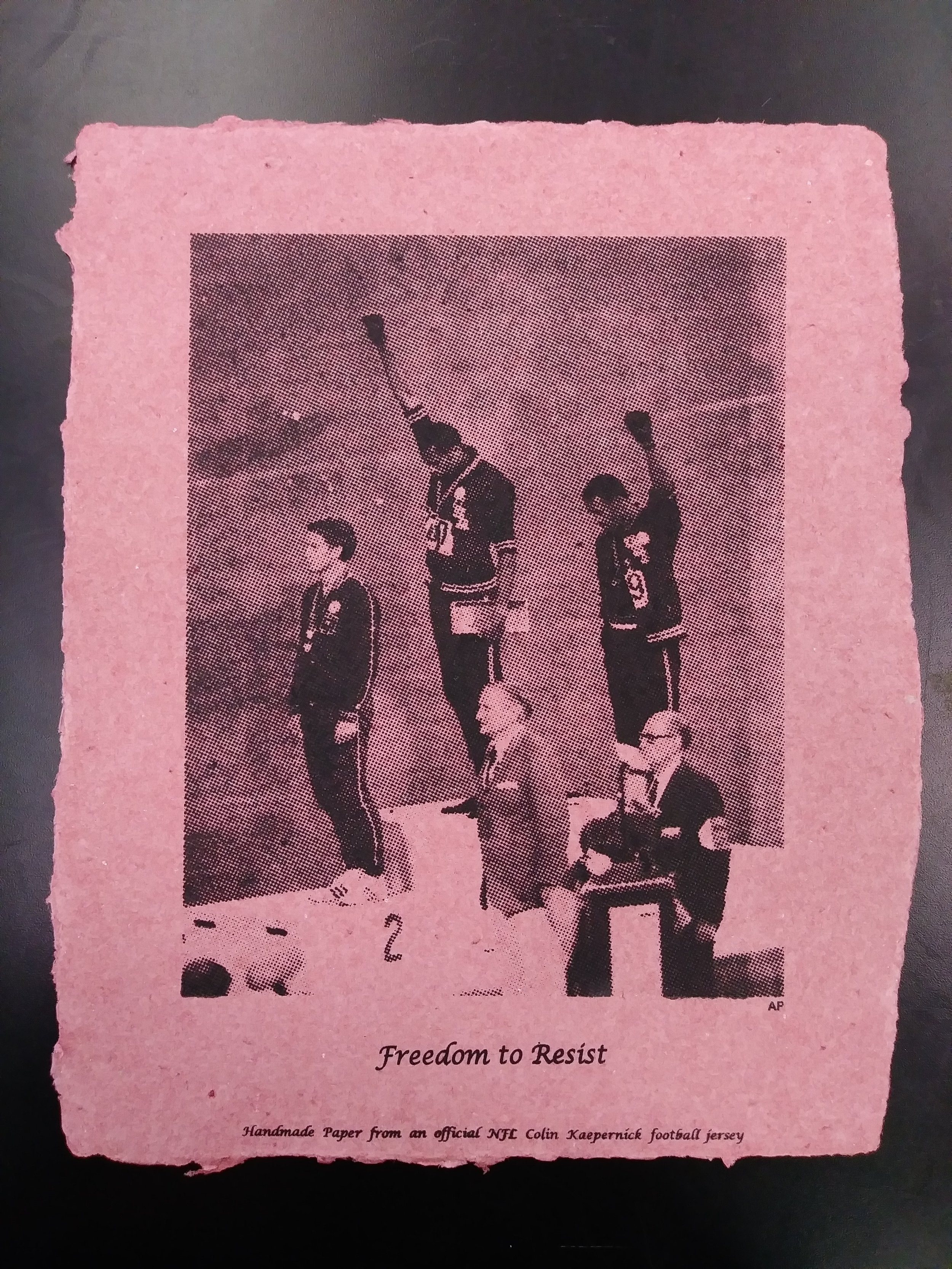What is your name?
James Yee
Where are you from?
I grew up in Springfield, NJ. I currently reside in Bloomfield, NJ. I am a third generation Chinese American
Have you thought of a name for your dream studio and where to put down roots?
No, but for the moment I am quite settled here in New Jersey.
Who are your favorite artists and biggest inspirations?
I appreciate the calligraphy art of Hajj Noor Deen. He is from China, and he is an expert in Arabic calligraphy. He incorporates a unique Chinese style into his pieces of traditional Arabic calligraphy. I am Muslim and ethnically Chinese, so I feel a spiritual and ethnic connection to his work.
What kind of work have you done as an artist, if applicable?
I am mostly engaged in handmade papermaking from old military uniforms; and then using that paper to create something artistically that is in some way reflective of my military experience. Besides using my own decommissioned military uniforms, I have also made paper from other clothing sources, including garments from Syrian and Iraqi refugees, a commercial NFL Colin Kaepernick football jersey, and some clothing from my late father who passed away in 2020 from Covid-19.
Where did you discover art making and how did you get into it?
I discovered making art at the Printmaking Center of New Jersey, which later became Frontline Arts. I was connected to this print studio by the art program at Montclair State University, which at the time, had a papermaking course for student veterans called “Combat Paper”
USMA 90 Class Crest / Printed on handmade paper
What are some of the key topics that you choose to discuss when creating your works and why?
When I use the paper made from my own military uniforms, I focus on creating something that in some way relates to my personal journey of eighteen years in the U.S. Army. I served seven years on active duty, seven years in the U.S. Army Reserves, and four years as a cadet at the U.S. Military Academy at West Point.
When I use the paper I make from other clothing sources, I always try to create some type of imagery that relates or connects to that particular clothing source. For example, on the paper I made from the clothing of a Syrian refugee, I made a color silkscreen print of the Syrian flag superimposed by silhouettes of what appear to be refugees or what could be individuals displaced by civil war.
Syrian Exodus / Printed on handmade paper
In another example, on the paper I made from a Colin Kaepernick NFL football jersey, I made a series of black and white silkscreen prints of professional athletes that demonstrated or knelt during the playing of the national anthem.
What does the word ‘chaplain’ mean to you?
A chaplain in the military is an officer who provides religious support to those serving in the U.S. military, to civilians living or employed on a U.S. military installation, and to individuals who are imprisoned by the U.S. military. Providing religious support and accommodation is done to uphold the free exercise of worship guaranteed by the First Amendment of the U.S. Constitution. In 2001, I became among our nation’s first Islamic chaplains to serve in the U.S. military. And in late 2002, I was assigned to Guantanamo Bay as the chaplain of the notorious military prison camp that holds suspected terrorists in the so-called “war on terror”. I wrote about that experience in a book entitled “For God and Country: Faith and Patriotism Under Fire”
Can you tell us about your piece “Why Did You Leave”?
I made this piece in the Combat Paper class at Montclair State University. It’s a silkscreen image of the World Trade Center printed on handmade paper from military uniforms. The image includes the question “Why Did you Leave?” My intention was to use this question as a prompt or conversation starter in hopes that one viewing the piece would stop for a moment and contemplate deeper into tragic attacks on 9-11. The attack on the World Trade Center was a ruthless act of terror that led to the total destruction of the twin towers and several other surrounding buildings, in addition to the nearly 3000 lives lost. Perhaps the gravity of the event demands that it be further examined as to how and why U.S global policies, practices and politics creates such a deep-seated animosity in others that they would go to such extremes.
Why Did You Leave? 1 / Printed on handmade paper
Can you tell us about your piece “Guantanamo Prayers”?
“Guantanamo Prayers” is a print made from a plexiglass etching printed on handmade paper from military uniforms. The image gives a snapshot of Guantanamo prisoners performing Muslim prayer in the early days of Guantanamo Bay where the men were kept outside in the cage-like cells of Camp X-Ray. One might take notice of the Cuban wildlife that is free to crawl or fly, in contrast to the prisoners who are confined without freedom.
Guantanamo Prayers for Freedom / Printed on handmade paper
How did you first come into contact with Frontline Arts, and what is your experience like as a Frontline Paper / Mobile Workshop Instructor?
I first came into contact with the Combat Paper NJ program in 2013 at the Print Center of New Jersey through a fellowship I was awarded by veteran nonprofit organization The Mission Continues. I became an active participant in the program’s weekly Sunday workshop for veterans and was with the organization as it transitioned to Frontline Paper/Frontline Arts. Later I began assisting as a workshop facilitator when needed. I enjoy being active on the mobile workshops as a Frontline team member. It’s inspiring seeing veterans going through the entire papermaking process from start to finish creating art to tell their stories.
What was your experience like when you wrote your book “For God and Country: Faith and Patriotism under Fire”?
“For God and Country: Faith and Patriotism Under Fire” is a first-hand account of my high profile assignment as the U.S. Army Muslim Chaplain at Guantanamo Bay. Authoring the book was intense. I officially separated from the military in January 2005, signed a contract with a publisher in March with the first draft due three months later in June. I got the final draft to the publisher in time to be printed and in bookstores for an early October launch. I learned a great deal about the publishing industry, and I was very fortunate to find a great writer in Aimee Molloy to co-author the book with me. The book reads very much like a memoir while documenting a harrowing ordeal in which I experienced military prisons from both sides of the bars.
Any additional words or comments you would like to share with readers?
Do more of what you like. For me that means continue making handmade paper from military uniforms and creating art.
For more information, please visit:
https://www.bbc.co.uk/programmes/w3ct34vy
https://www.theguardian.com/lifeandstyle/2021/jun/04/experience-i-was-an-imam-at-guantanamo-bay
Interview by Hugo Gatica, November 2022








